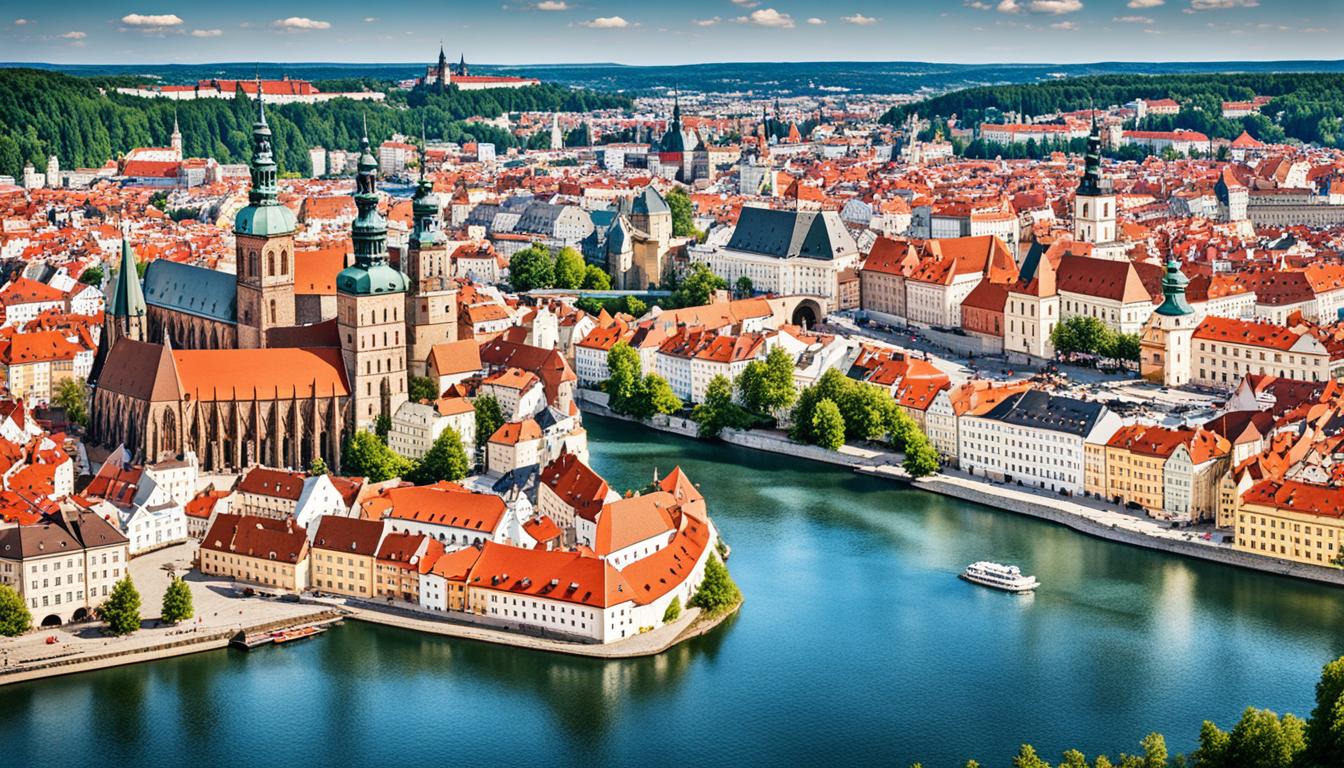In the heart of Central Europe lie Poland and Czechia, both rich in history and modern vibrancy. This comparison between Poland and Czechia highlights the factors that shape these nations, both separately and together. They have unique ties, molded by their shared land, different population sizes, and diverse government systems.
To really understand these two neighbors, we must delve into their global positions, cultural heritage, and economic statuses. This deeper look reveals their individual value and their contribution to the broader Central European scene. The goal here is not just to compare, but to also value what makes each country special.
Key Takeaways
- Poland and Czechia, two pivotal Central European countries, exhibit compelling contrasts and comparisons.
- Analysing Poland Czechia relations offers insights into their unique political, geographic, and socio-economic dynamics.
- Poland’s larger population size impacts its regional influence when compared to Czechia.
- Both nations share a commitment to maintaining their cultural legacies and identities within Central Europe.
- The global standings of Poland and Czechia are marked by their integration and roles within the European Union.
- Examining the interplay between these countries aids in understanding the fabric of Central European geopolitics.
Economic Indicators: Poland and Czechia Explored
Examining the economies of Poland and Czechia uncovers vital signs. These show their financial health and their place in Central Europe’s competition. By looking closely at GDP, unemployment, and trade, we can understand their economic climate and growth paths.
Gross Domestic Product (GDP) Comparisons
GDP figures for Poland and Czechia are crucial. They help us see their economic size and output. Both countries stand out in Central Europe. They have unique economic strengths showing their growth and financial strength.
| Indicator | Poland | Czechia |
|---|---|---|
| Nominal GDP (USD) | 594.16 billion | 246.49 billion |
| GDP Growth Rate (%) | 3.6 | 2.9 |
| GDP per capita (USD) | 15,696 | 23,202 |
Unemployment Rates and Economic Growth
Comparing unemployment in Poland and Czechia offers insights into their job markets and growth. Both aim for low unemployment to strengthen their economies. This ambition is common to them.
According to latest figures, Czechia has one of Europe’s lowest unemployment rates. This shows its strong industries and efficient job market.
Trade Relationships and FDI Inflows
Trade and investment are key for Poland and Czechia, as well as their global partners. Their strategic location helps them draw in foreign investments. This boosts their economies.
- Export-Import Dynamics
- Investment Hotspots
- Bilateral Trade Agreements
Through trade and FDI, their economic stories gain depth. They get capital that drives tech advances and builds infrastructure.

Poland vs Czechia: Cultural and Historical Perspectives
Poland and Czechia share a deep history and unique cultural stories. Exploring these aspects helps us understand their relationship. This understanding highlights how their past and identities interlink.
Historical Ties and Conflicts
The history of Poland Czechia is full of alliances and disagreements. Over the years, they’ve seen many key moments. These include peace agreements and land arguments. These events shaped their borders and identities.
Linguistic and Ethnographic Differences
This area is known for its linguistic diversity. Polish and Czech languages stem from the same Slavic family but are different. These differences highlight diverse cultural traits in Poland and Czechia. It shows how culture can vary across borders.
Influence of European History on National Identities
European influence has deeply affected Poland and Czechia. Empires, wars, and revolutions have formed their modern identities. They share a history with Europe that has moulded their societies.
Conclusion
This summary of Poland and Czechia shows their unique but sometimes similar journeys. By comparing them, we learn about their identities and how they fit into geography, economy, and culture. Even though they are close and share history, Poland and Czechia have their own roles globally.
The economic review shows Poland’s GDP is bigger than Czechia’s. Still, both attract trade and investment. Our look into their cultures and history reveals deep stories. These stories shape how they see themselves today. Their languages and traditions, amid Europe’s influence, show their unique identities.
It’s hard to say what the future holds for Poland and Czechia. But, their bond will likely grow through trade, culture, and shared history. The coming years might bring them closer or highlight their differences. Either way, they’ll impact their people and Europe’s story on the world stage.
FAQ
What are the main differences between Poland and Czechia?
Poland and Czechia differ in size, population, politics, and global roles. Poland is bigger and has more people. It also has a unique political system and plays a different role on the world stage.
How do the economies of Poland and Czechia compare?
Looking at their economies, we compare GDP, job rates, and growth. Poland’s economy is larger. Yet, Czechia often has lower unemployment and performs well economically for its size. Their economic status is also shaped by trade and foreign investments.
What are the historical and cultural relationships between Poland and Czechia?
Poland and Czechia have a history of both conflict and cooperation. These have affected their cultural and political ties. They have unique languages and cultures but share Slavic roots and a European history. This influences their national identities.
How do trade relationships affect the economies of Poland and Czechia?
Trade impacts Poland and Czechia’s economies greatly. It shows how they connect with the EU and globally. Good trade leads to economic growth and attracts investments. This boosts their economies.
How does linguistic diversity play a role in the cultural differences between Poland and Czechia?
Linguistic diversity sets Poland and Czechia apart culturally. Poland speaks Polish, and Czechia speaks Czech. These languages reflect their unique cultures and histories. They both come from the West Slavic group but have evolved differently.
Are there significant economic growth opportunities in Poland and Czechia?
Poland and Czechia have big chances for economic growth. Their location in Central Europe, skilled workers, and EU membership help. They also draw in foreign investments and have strong trade relationships.
Can you compare the impact of European history on the national identities of Poland and Czechia?
European history deeply affected Poland and Czechia’s identities. Wars, empires, and revolutions have shaped how they see themselves. Despite European influences, these events helped build their strong national identities.



